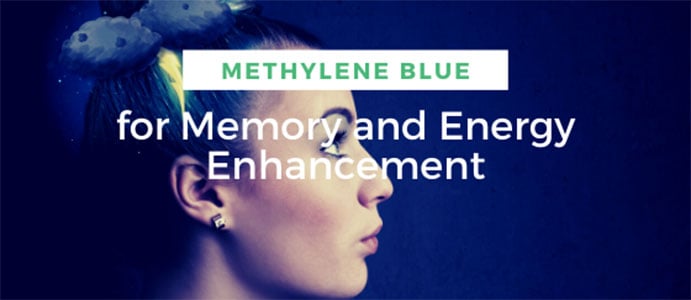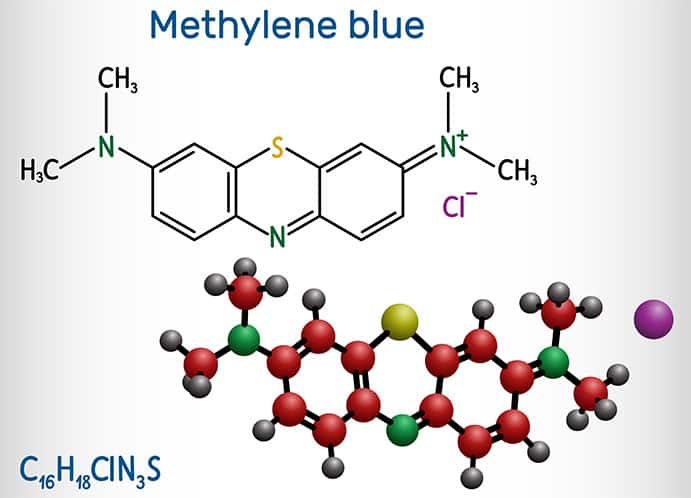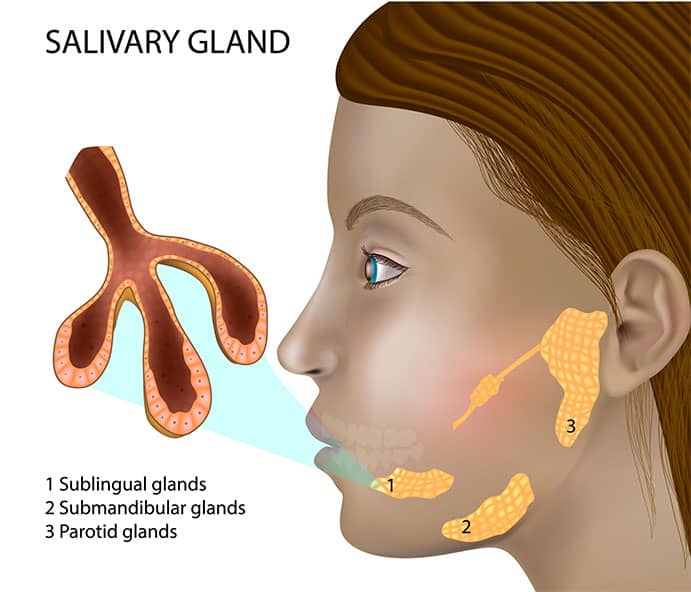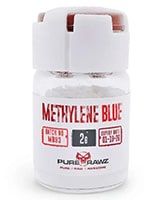

Originally a 19th-century textile dye, methylene blue has emerged as a potent 21st-century nootropic for memory, energy, and mood optimization. In this article, we’re going to take a look at a brief history of this synthetic compound and then unpack its benefits, dosing, and safety. We’ll also explore how it exerts its beneficial effects in the brain–a unique mechanism of action that differs from most other cognitive enhancers out there.
>> Looking to Buy Methylene Blue? Click here to see our recommended sellers.
What is Methylene Blue? From Textile Dye to Potent Nootropic

This synthetic compound has a long history of use that dates back over 140 years. After its synthesis in 1876, it was used as a blue dye in the Industrial Revolution and then shifted into the hands of chemists and physicians later in the 19th century. It was then that this dye was coined the “magic bullet” once it was discovered to have surprising pharmaceutical properties.
Not long later, physicians began using it to treat a variety of illnesses from cyanide poisoning to mood disorders, malaria, UTIs, and more. Recently, methylene blue is a promising neuroprotective agent, and clinical studies are supporting its use to treat neurodegenerative diseases such as Alzheimer’s disease.[1]Rojas JC, Bruchey AK, Gonzalez-Lima F. Neurometabolic mechanisms for memory enhancement and neuroprotection of methylene blue. Progress in Neurobiology. 2012;96:32–45.
Methylene Blue boosts cellular metabolism
When methylene blue (MB) is ingested, it readily crosses the blood-brain barrier and preferentially accumulates in energy-intensive neurons. Instead of acting on a specific neurotransmitter system with a typical drug-receptor interaction like many nootropics, methylene blue acts on the energy metabolism machinery in the mitochondria of respiring neurons. The mitochondria are the powerhouse of the cell, converting oxygen and nutrients into energy-rich ATP molecules.
Here, MB upregulates cellular metabolism as a result of its unique chemical structure. It acts as an alternative electron carrier in the mitochondrial electron transport chain, a crucial mechanism in the generation of cellular energy and, ultimately, neuronal survival. Methylene blue helps cells produce ATP by shuttling electrons to oxygen. It has also been found to donate electrons to coenzyme Q and cytochrome C, thereby increasing the activity of a key respiratory enzyme called cytochrome oxidase. Taken together, these effects result in MB’s metabolic-enhancing properties.[2]Rojas JC, Bruchey AK, Gonzalez-Lima F. Neurometabolic mechanisms for memory enhancement and neuroprotection of methylene blue. Progress in Neurobiology. 2012;96:32–45.
Methylene blue is a potent antioxidant
The same mechanism of action underlying its metabolism-boosting properties also confers methylene blue potent antioxidant effects. Methylene blue scavenges free-floating electrons in cells, decreasing the production of oxygen-reactive species by reducing them harmlessly to water.[3]Rojas JC, Bruchey AK, Gonzalez-Lima F. Neurometabolic mechanisms for memory enhancement and neuroprotection of methylene blue. Progress in Neurobiology. 2012;96:32–45.[4]Gonzalez-Lima F, Barksdale BR, Rojas JC. Mitochondrial respiration as a target for neuroprotection and cognitive enhancement. Biochem Pharmacol. 2014;88(4):584–593.
With fewer of these around, there is a decrease in oxidative stress. Oxidative stress is a byproduct of numerous cellular reactions and is associated with mitochondrial dysfunction, nerve cell death, and overall systemic disease. [5]Gonzalez-Lima F, Barksdale BR, Rojas JC. Mitochondrial respiration as a target for neuroprotection and cognitive enhancement. Biochem Pharmacol. 2014;88(4):584–593.
Methylene blue has powerful memory-boosting properties

At low doses of approximately 4mg/kg body weight, methylene blue has been found in animal and human trials to significantly increase memory consolidation and retention in normal and diseased brains. These effects are found in a use-dependent fashion and extend to multiple measures of memory, including object memory recognition, spatial memory, working memory, long-term memory, and fear extinction.[6]Rojas JC, Bruchey AK, Gonzalez-Lima F. Neurometabolic mechanisms for memory enhancement and neuroprotection of methylene blue. Progress in Neurobiology. 2012;96:32–45.[7]Callaway NL, Riha PD, Bruchey AK, Munshi Z, Gonzalez-Lima F. Methylene blue improves brain oxidative metabolism and memory retention in rats. Pharmacol Biochem Behav. 2004;77:175–181.[8]Wrubel, K. M., Riha, P. D., Maldonado, M. A., McCollum, D., & Gonzalez-Lima, F. (2007). The brain metabolic enhancer methylene blue improves discrimination learning in rats. Pharmacology, biochemistry, and behavior, 86(4), 712–717.
In one 2016 study, 26 human subjects participated in sustained attention and short-term memory tasks one hour after low-dose methylene blue administration. Compared to placebo, methylene blue was found to significantly increase correct responses during memory retrieval and enhanced activity in the brain regions associated with the tasks.[9]Rodriguez P, Zhou W, Barrett DW, Altmeyer W, Gutierrez JE, Li J, Lancaster JL, Gonzalez-Lima F, Duong TQ. Multimodal Randomized Functional MR Imaging of the Effects of Methylene Blue in the Human Brain. Radiology. 2016;281(2):516–526.
MB’s memory-enhancing effects are thought to be due to a combination of its ability to increase oxygen consumption in cells and its interaction with cytochrome oxidase. MB increases oxygen consumption by increasing the concentration of hemoglobin with oxygen-carrying capacity. Additionally, its ability to increase cytochrome oxidase expression helps further regulate brain oxygen consumption and supports energy-demanding processes within cells such as neurotransmission and memory consolidation.[10]Rojas JC, Bruchey AK, Gonzalez-Lima F. Neurometabolic mechanisms for memory enhancement and neuroprotection of methylene blue. Progress in Neurobiology. 2012;96:32–45. [11]Gonzalez-Lima F, Barksdale BR, Rojas JC. Mitochondrial respiration as a target for neuroprotection and cognitive enhancement. Biochem Pharmacol. 2014;88(4):584–593.
MB’s neuroprotective effects stave off cognitive decline and support healthy brain function

With more energy available to respiring neurons, methylene blue can support peak brain performance. Age-related cognitive decline is associated with both an increase in oxidative stress levels and alterations in mitochondrial functioning. Low-dose methylene blue can help rescue mitochondrial function and ward off oxidative stress-induced damage.[12]Rojas JC, Bruchey AK, Gonzalez-Lima F. Neurometabolic mechanisms for memory enhancement and neuroprotection of methylene blue. Progress in Neurobiology. 2012;96:32–45. [13]Gonzalez-Lima F, Barksdale BR, Rojas JC. Mitochondrial respiration as a target for neuroprotection and cognitive enhancement. Biochem Pharmacol. 2014;88(4):584–593.
Methylene blue may even help slow the progression of several common neurodegenerative diseases. Neurotoxic proteins such as tau and beta-amyloid in Alzheimer’s disease and huntingtin protein in Huntington’s disease aggregate and disrupt neuronal communication, ultimately resulting in cell death.
Methylene blue has been shown in animal and in vitro studies to prevent the clumping of these pathological proteins. Concerning Alzheimer’s disease, MB boosts neuronal resistance to amyloid plaques and neurofibrillary tangles, two major features associated with the disease.[14]Rojas JC, Bruchey AK, Gonzalez-Lima F. Neurometabolic mechanisms for memory enhancement and neuroprotection of methylene blue. Progress in Neurobiology. 2012;96:32–45.[15]Atamna H, Kumar R. Protective role of methylene blue in Alzheimer’s disease via mitochondria and cytochrome c oxidase. J Alzheimers Dis. 2010;20(Suppl 2):S439–452.
While human clinical studies with MB are limited, it has shown promising results in staving off Alzheimer’s disease progression in its early stages. In one 2008 phase II clinical trial, 60mg of a methylene blue derivative administered three times daily was found to slow disease progression in mild and moderate Alzheimer’s disease cases over 50 weeks.[16]Gura T. Hope in Alzheimer’s fight emerges from unexpected places. Nature medicine. 2008;14(9):894.
Methylene Blue Dosing

Methylene blue’s nootropic effects are found at low doses between 0.5mg/kg – 4mg/kg body weight. For someone weighing 80kg (176lb), this means a dose range of 40mg-320mg. Of course, it’s always a good idea to start with the lowest dose to judge how your body chemistry reacts to it.
When taking MB, sublingual administration has the highest bioavailability but be warned, it will stain the inside of your mouth blue. Since methylene blue is water-soluble, it must not be taken with fats for optimal absorption.
Methylene blue has a hormetic dose-response relationship, which means it has opposite effects at low and high doses. At high doses (exceeding 5mg/kg), it begins to disrupt mitochondrial electron transport function and acts as a pro-oxidant (rather than an antioxidant). Indeed, low doses of MB can treat a rare blood disorder called methemoglobinemia, while high doses can cause it by interfering with red blood cells.[17]Bruchey AK, Gonzalez-Lima F. Behavioral, Physiological and Biochemical Hormetic Responses to the Autoxidizable Dye Methylene Blue. American journal of pharmacology and toxicology. 2008;3(1):72–9.
Methylene Blue Safety and Cautions
Methylene blue has a half-life of approximately 12 hours. Several hours after ingestion, it begins to be eliminated through the kidneys. The unmetabolized version of the drug will remain in the urine at doses exceeding approximately 0.5mg/kg, which causes urine to harmlessly stain blue.
MB is generally well-tolerated in the nootropic dose range, but rare side effects may include hypertension, headache, dizziness, chest pain, stomach pain, tremor, and jaundice.
It’s important to note that MB is known to inhibit monoamine oxidase, an enzyme that is involved in the degradation of monoamine neurotransmitters like serotonin and norepinephrine. To avoid the risk of serotonin syndrome, avoid using methylene blue if you’re taking antidepressants or antianxiety medications that increase serotonin levels.
Lastly, if you decide MB is for you, choose a reputable seller that offers pharmaceutical-grade (USP) rather than lab-grade or aquarium-grade MB. Even pharmaceutical-grade MB can contain heavy metal impurities, so it’s always a good idea to ask for a certificate of analysis that will list the amounts of contaminants such as mercury, lead, cadmium, arsenic, and aluminium.
Buy Methylene Blue Online Review Comparison Table
| Product | Company | Quantity | Price | Country | Website |
 Methylene Blue | PureRawz | 2g | $12.48 |  Worldwide, US, AU | Visit Website >> |
Originally posted on January 31, 2020, last updated on April 1, 2024.
References
| ↑1, ↑2, ↑3, ↑6, ↑10, ↑12, ↑14 | Rojas JC, Bruchey AK, Gonzalez-Lima F. Neurometabolic mechanisms for memory enhancement and neuroprotection of methylene blue. Progress in Neurobiology. 2012;96:32–45. |
|---|---|
| ↑4, ↑5, ↑11, ↑13 | Gonzalez-Lima F, Barksdale BR, Rojas JC. Mitochondrial respiration as a target for neuroprotection and cognitive enhancement. Biochem Pharmacol. 2014;88(4):584–593. |
| ↑7 | Callaway NL, Riha PD, Bruchey AK, Munshi Z, Gonzalez-Lima F. Methylene blue improves brain oxidative metabolism and memory retention in rats. Pharmacol Biochem Behav. 2004;77:175–181. |
| ↑8 | Wrubel, K. M., Riha, P. D., Maldonado, M. A., McCollum, D., & Gonzalez-Lima, F. (2007). The brain metabolic enhancer methylene blue improves discrimination learning in rats. Pharmacology, biochemistry, and behavior, 86(4), 712–717. |
| ↑9 | Rodriguez P, Zhou W, Barrett DW, Altmeyer W, Gutierrez JE, Li J, Lancaster JL, Gonzalez-Lima F, Duong TQ. Multimodal Randomized Functional MR Imaging of the Effects of Methylene Blue in the Human Brain. Radiology. 2016;281(2):516–526. |
| ↑15 | Atamna H, Kumar R. Protective role of methylene blue in Alzheimer’s disease via mitochondria and cytochrome c oxidase. J Alzheimers Dis. 2010;20(Suppl 2):S439–452. |
| ↑16 | Gura T. Hope in Alzheimer’s fight emerges from unexpected places. Nature medicine. 2008;14(9):894. |
| ↑17 | Bruchey AK, Gonzalez-Lima F. Behavioral, Physiological and Biochemical Hormetic Responses to the Autoxidizable Dye Methylene Blue. American journal of pharmacology and toxicology. 2008;3(1):72–9. |

I would like to read the updated review on MB story, especially clinical studies and outcomes. Thank you for a good MB review